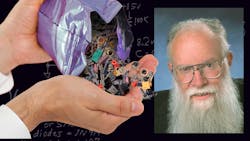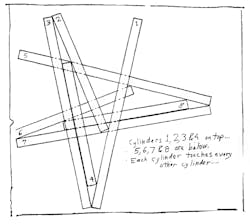This article is part of Bob Pease's Floobydust series found in the Electronic History section of our Series Library.
Well, it's time for another assortment of miscellaneous, or what I like to call "Floobydust" topics. But first, let's start with the solution for Puzzler 1 that ran in the last issue.
I'll restate it: Four guys named Ari, Ben, Cal, and Don must cross a bridge, but the bridge can only hold two men at a time. It's dark, and they have only one flashlight, which they must use to cross the bridge. If two guys cross using the flashlight, one guy will have to come back carrying the flashlight. (They cannot throw the flashlight across.) Ari takes one minute to cross; Ben is slower at two minutes; Cal is slower at five minutes; and Don is very slow at 10 minutes. Everybody must cross within 17 minutes.
If the fastest walker, Ari, crosses with each of the other three guys, and returns as needed, that will take 19 minutes. How can we beat that? Obviously, if the two slower guys each go across separately, there's 15 minutes shot right there. In order to gain any advantage, we have to get the two slow guys to cross together. Now do you see the solution?
First trip: Ari and Ben cross. At the end, Ari and Ben cross again. In the middle, the two slow guys cross together, thus incurring a minimum penalty. They can cross together because Ari carried the flashlight back (trip two) and left Ben. After the two slow guys have crossed, Ben carries the flashlight back (trip four) to get Ari. BUT, it does not make any difference if Ari does trip two and Ben does trip four, or vice versa. The total is still 17 minutes. Those are the two solutions. (Jim Ball suggests that Ari can carry each other guy across, taking five minutes total, an elegant rule bender.)
At first, I took about two minutes to work on the puzzle, and I saw the 19-minute solution. I knew I did not have my finger on any 17-minute solution. I then had to get back to work. A few days later I had a few minutes, so I took up the puzzle again, and solved it in three or four minutes. A neat trick. I saw this on the Internet. I'm passing it around not because it is a very hard puzzler, but because it is fun.
My Beetle Dies: I was going to run my 1968 Volkswagen Beetle forever, but it was cruelly murdered by a single steel cable, 3 ft. off the ground, with no flag or warning on it. It wrecked the poor little car's front pillars, bashed in the windshield, and sprung the body—not worth repairing. Fortunately I was only going 4 mph, and only got scratches on four fingers. Not even a bump or scratch on my head. The engine was salvageable, though. The car went to the junkyard at 365,200 mi. It didn't owe me a thing.
So what did I buy to replace it? I was thinking about a good 1968 or '69 Beetle, but I bought a newer car—a clean 1970 Beetle with only 112,000 mi. on it.
GPS Receivers: If you thought that $400, $300, $200, or even $100 is too much to pay for a GPS receiver, how about $99.99? Magellan's new Pioneer has some pretty good features at that price. (Call Cabela's at (800) 237-4444, or your favorite retailer.) I'm sure competitors will be right behind.
I got a good Garmin GPS38 model a year ago for about $170, and it works fine. It even worked fine in Nepal. And, I do not begrudge the $70.01 that I "overpaid."
Altimeters: Okay, a GPS machine is not very useful on a trek in Nepal (where the sherpas know exactly where we are camping, and you can hardly get lost, because there isn't a lot of choice as far as trails go). How about a recording altimeter? My wife wanted one for our trek. I thought that bringing an altimeter was a bit silly. But when my wife gives me a solution to the question, "What should I get her for her birthday," I don't argue. We checked out the Avocet Vertech, a combination watch-altimeter, which costs about $140. It seemed to have the right features.
Nancy wore it on the trip. Was it a silly thing to bring? Nope. The third day on the trail, I pulled into camp at Dharapani, good and tired. Why? Nancy pointed out that even though we had only ascended from 4300 ft. to 6440 ft.—and climbing 2140 ft. did not sound like a lot of work—actually we had ascended a total of 4300 ft., and descended 2160 ft. No wonder I was a little worn out! So, the recording altimeter can provide a sanity check!
The trek involved starting at 2650 ft. at BesiSahar, ascending to 17,771 ft. at Thorong La, descending to Tatopaani at 4200 ft., back up to 9700 ft. at Ghorepani, and down to the road at New Bridge at 3000 ft. That sounds like about 20,600 ft. of rise, and 20,300 ft. of fall. But by the end of the trip, Nancy was able to show that we had actually ascended and descended about 38,000 ft. I was impressed! So I am going to stop being so skeptical about what my wife wants to bring on a trek!
Thermistors: Back in November, I talked about using thermistors over a wide temperature range, such as in your home oven. But who makes thermistors that will cover that wide range? I finally found a data sheet by Keystone Thermometrics located in St. Marys, Penn.; (814) 834-9140. They have one model OVHT(A-1288) that is rated from room temperature up to 500 °C, which is 932 °F, a good safe margin above the 700 °F of a self-cleaning oven.
That's the good news. But are these thermistors inexpensive? The bad news is that this thermistor is packaged in stainless steel for good reliability, and thus is NOT cheap. About $30 in 100's. Also, the gain (logarithmic characteristic) of the thermistor varies by about a factor of 1.8:1, between 50 °C and 250 °C. This is not a serious problem. It would still be fairly easy to make a good oven thermostat using such a device, but it just reminds us that thermistors are not always simple and easy to use, over wide temperature ranges. The thermocouple looks better and better.
Thermocouples: That reminds me—one guy pointed out that in my November circuit for thermocouples, I showed the thermocouple connected incorrectly, backwards. The red lead is NOT positive at hot temperatures. The yellow lead is. You would have figured this out, if you had built it. I have labeled this kind of thermocouple correctly in the past.
Other Thermistors: Keystone does make another thermistor, type AUHT(A-1291), that is characterized between 250 °C (R = 6.01 M?) and 1000 °C (R = 590 ?). That's pretty impressive! Again, the packaging in stainless steel is NOT cheap—about $40—and it may well be worth it! Do other manufacturers make thermistors rated above 300 °C? I called around and couldn't find a one.
Puzzler Answer: A year ago, I said that you could arrange seven long cylinders so that each one touches the other six. A very small number of readers had the right solution, the same as I did. But one reader came up with a solution of eight cylinders, all the same diameter (see the figure). The long cylinders have to be at least as long as about 22 times the diameter, and the shorter ones have to be about 13 times the diameter—they have to be down near 60% of the long ones. And they all do touch! Each of the eight touches the other seven. I like it!
Servo Circuit: A guy named Jerry wished for a circuit to drive a Screw Motor with a Feedback Resistor Servo. The circuit in my Ball-on-Beam Balancer was pretty good (Electronic Design Analog Supplement, Nov. 20, 1995, p. 50) . It never gave me any trouble. Since Jerry did not give me a return address, that's the best advice I can give him.
IC Logos: I got a nice book from Karen Mittelstadt at Sams Publisher: Component Identifier and Source Book, by Victor Meeldijk, Prompt Publications (a subsidiary of Sams), ISBN 0-7906-1088-4, about $25. It lists all the logos of all IC's made. A useful resource for the library of any big, serious, electronics company. But as several readers pointed out, if you have IC Master, you might have a lot of that logo info in there, already.
Epaminandas: After reading my story of Epaminandas , one reader pointed out that you can buy a little book—he searched it out at Amazon Books: Epaminondas and His Auntie, by Sara Cone Bryant (Electronic Design, Oct. 23, 1997, p. 151). At about $12 including tax and shipping, I bought the book. In its 16 pages, it had several drawings of little boys, and about the same story as I told. I think I told it better. Hardly a good investment, unless you are a nut about such stories. But it was amusing to see that it was not out of print.
Books as small as this, with just five pages of text, do not usually get an ISBN number (0-89966-556-x), but this one did. Stories as old as that one do not usually get a 1976 copyright date. But this one did.
One reader upbraided me, because my mother's "abuse" of me (she gave me a whack, which I well deserved, for spilling my milk) caused me to be brutal and abusive to others when I grew up. He claimed I was thus brutal to my children, causing a continuing pattern of brutality. This foolish (and anonymous) writer did not recognize that I plainly stated that when my son tried to pull his glass away, I was careful to not let him spill a drop. I didn't have to whack him. So, Mr. Anonymous, I don't think that a parental swat or spank necessarily constitutes "brutality." I wouldn't buy your theory, even if you had signed your name.
More Speaker Cables: If you want to see some OUTRAGEOUS, preposterous claims about high-end speaker cables, check out these web sites: http://www.nordost.com and http://www.cardas.com.
Taguchi: It seems that most Taguchi experts are not worth wasting your time on. But when Professor T. N. Goh from Singapore University comes to town, I want to see his proposals. He claims he can make Taguchi methods work well. I tend to believe him. (I'm not sure if I should say anything good about Prof. Goh, because I want his success to depend upon what he says, not what I say about him. Still, I want people to attend his lectures. A quandary....)
Read What's All This Floobydust Stuff, Anyhow? (Part 7)
All for now. / Comments invited!
RAP / Robert A. Pease / Engineer
[email protected]—or:
Mail Stop D2597A
National Semiconductor
P.O. Box 58090
Santa Clara, CA 95052-8090
About the Author

Bob Pease
Bob obtained a BSEE from MIT in 1961 and was a staff scientist at National Semiconductor Corp., Santa Clara, CA, for many years. He was a well known and long time contributing editor to Electronic Design.
We also have a number of PDF eBooks by Bob that members can download from the Electronic Design Members Library.

